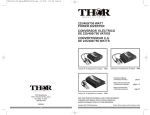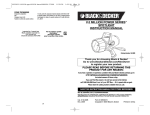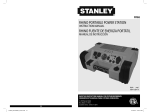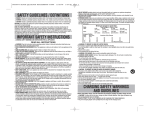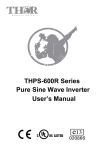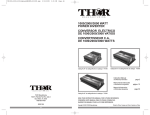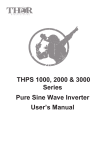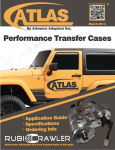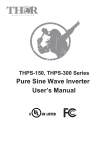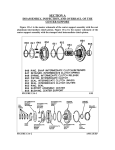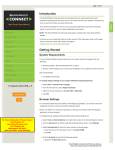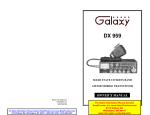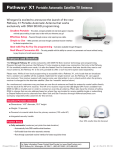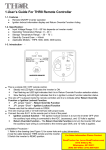Download 225/400/750 watt power inverter conversor eléctrico
Transcript
TH225_400_750_ManualENSPFR_051010.qxp 5/10/2010 2:27 PM Page 36 225/400/750 WATT POWER INVERTER CONVERSOR ELÉCTRICO DE 225/400/750 VATIOS CONVERTISSEUR C.A. DE 225/400/750 WATTS For Sales Information Please Contact RoadTrucker Inc (www.RoadTrucker.com) 8312 Sidbury Rd. Wilmington, NC 28411 (800) 507-0482 / (910) 686-4281 Catalog No./N.º de catálogo/Numéro de catalogue Catalog No./N.º de catálogo/Numéro de catalogue TH225 Instruction Manual and Warranty Information Manual de la instrucción e información de la garantía Manuel d’instruction et l'information de garantie Catalog No./N.º de catálogo/Numéro de catalogue THOR Manufacturing 7040 W. Palmetto Park Rd., Suite 4 Boca Raton, FL 33433 1-866-955-THOR RD051010 TH400 page 2 página 12 page 23 TH750 SAVE THIS INSTRUCTION MANUAL FOR FUTURE REFERENCE. CONSERVE ESTE MANUAL PARA FUTURAS CONSULTAS. GARDEZ CE MANUEL POUR LA FUTURE RÉFÉRENCE. Copyright © 2010 THOR Manufacturing 36 Printed in China / Impreso en China / Imprimé en Chine 1 For Sales Information Please Contact RoadTrucker Inc (www.RoadTrucker.com) 8312 Sidbury Rd.; Wilmington, NC 28411 - (800) 507-0482 / (910) 686-4281 TH225_400_750_ManualENSPFR_051010.qxp 5/10/2010 2:27 PM Page 2 GENERAL SAFETY WARNINGS AND INSTRUCTIONS SAFETY GUIDELINES AND DEFINITIONS DANGER: Indicates an imminently hazardous situation which, if not avoided, will result in death or serious injury. WARNING: Indicates a potentially hazardous situation which, if not avoided, could result in death or serious injury. CAUTION: Indicates a potentially hazardous situation which, if not avoided, may result in minor or moderate injury. CAUTION: Used without the safety alert symbol indicates potentially hazardous situation which, if not avoided, may result in property damage. RISK OF UNSAFE OPERATION. When using tools or equipment, basic safety precautions should always be followed to reduce the risk of personal injury. Improper operation, maintenance or modification of tools or equipment could result in serious injury and property damage. There are certain applications for which tools and equipment are designed. Manufacturer strongly recommends that this product NOT be modified and/or used for any application other than for which it was designed. READ ALL INSTRUCTIONS WARNING: Read all instructions before operating your inverter. Failure to follow all instructions may result in electric shock, fire and/or serious injury. • AVOID DANGEROUS ENVIRONMENTS. Don’t use inverters in damp or wet locations. • KEEP CHILDREN AWAY. Keep away from children. This is not a toy! • STORE INDOORS. When not in use, inverters should be stored indoors in dry, and high or locked-up places – out of reach of children. • DON’T ABUSE CORD. Never carry inverter by cord or yank the cord to disconnect from receptacle. Keep cord from heat, oil, and sharp edges. • DISCONNECT INVERTER. Disconnect the inverter from the power supply when not in use. • PROPER COOLING is essential when operating the inverter. Do not place it near a vehicle’s heat vent or in direct sunlight. • USE OF ACCESSORIES AND ATTACHMENTS. The use of any accessory or attachment not recommended by manufacturer for use with this inverter could be hazardous. • STAY ALERT. Use common sense. Do not operate inverter when you are tired. • CHECK FOR DAMAGED PARTS. Any part that is damaged should be properly repaired or replaced by an authorized service center unless otherwise indicated elsewhere in this instruction manual before further use. Do not use inverter if switch does not turn it on and off. • DO NOT OPERATE inverter near flammable liquids or in gaseous or explosive atmospheres. Motors in tools or appliances used with the inverter may spark, and the sparks might ignite fumes. IMPORTANT SAFETY INSTRUCTIONS WARNING: This product or its power cord may contain lead, a chemical known to the State of California to cause cancer and birth defect or other reproductive harm. Wash hands after handling. WARNING: TO REDUCE THE RISK OF ELECTRIC SHOCK: • DO NOT connect to AC distribution wiring. • DO NOT make any electrical connections or disconnections in areas designated as IGNITION PROTECTED. This inverter is NOT approved for ignition protected areas. • NEVER immerse the inverter in water or any other liquid, or use when wet. • DO NOT insert foreign objects into the inverter’s outlets. WARNING: TO REDUCE THE RISK OF FIRE: • Do not operate near flammable materials, fumes or gases. • DO NOT expose to extreme heat or flames. CAUTION: TO REDUCE THE RISK OF INJURY OR PROPERTY DAMAGE: • Remove appliance plug from outlet before working on the appliance. • DO NOT attempt to connect or set up the inverter or its components while operating your vehicle. Not paying attention to the road may result in a serious accident. • ALWAYS use the inverter where there is adequate ventilation. Do not block ventilation slots. • ALWAYS turn the inverter off by disconnecting it from the power source when not in use. • The inverter MUST be connected only to batteries with a nominal output voltage of 12 volts. The unit will not operate from a 6 volt battery and will sustain permanent damage if connected to a 24 volt battery. • When using this unit in a vehicle, check the vehicle owner’s manual for maximum power rating and recommended output. DO NOT install in engine compartment — install in a well ventilated area. • DO NOT use with positive ground electrical systems.* Reverse polarity connection will result in a blown fuse and may cause permanent damage to the inverter and will void warranty. *The majority of modern automobiles, RVs and trucks are negative ground. • Keep in mind that this inverter will not operate high wattage appliances or equipment that produce heat, such as hair dryers, microwave ovens and toasters. • Do not open the inverter — there are no user-serviceable parts inside. Opening the inverter will void manufacturer’s warranty. • Do not use this inverter with medical devices. It is not tested for medical applications. • Install and operate unit only as described in this Instruction Manual. • Check inverter periodically for wear and tear. Return to manufacturer for replacement of worn or defective parts immediately. Read And Understand This Instruction Manual Before Using This Inverter. SAVE THESE INSTRUCTIONS WARNING: TO REDUCE THE RISK OF INJURY: FOLLOW THESE INSTRUCTIONS AND THOSE PUBLISHED BY BATTERY MANUFACTURER AND THE MANUFACTURER OF ANY EQUIPMENT YOU INTEND TO USE WITH THIS UNIT. REVIEW CAUTIONARY MARKINGS ON THESE PRODUCTS AND ON ENGINE. TABLE OF CONTENTS Introduction . . . . . . . . . . . . . . . . . . . . . . . . . . . . . . . . . . . . . . . . . . . . . . . . . . . . . . . . . . . . . . . . . . . . . . . . . . . 3 Features . . . . . . . . . . . . . . . . . . . . . . . . . . . . . . . . . . . . . . . . . . . . . . . . . . . . . . . . . . . . . . . . . . . . . . . . . . . . . . 4 Controls and Functions . . . . . . . . . . . . . . . . . . . . . . . . . . . . . . . . . . . . . . . . . . . . . . . . . . . . . . . . . . . . . . . . 4 How These Inverters Work . . . . . . . . . . . . . . . . . . . . . . . . . . . . . . . . . . . . . . . . . . . . . . . . . . . . . . . . . . . . . . . 5 Power Inverter Output Waveform . . . . . . . . . . . . . . . . . . . . . . . . . . . . . . . . . . . . . . . . . . . . . . . . . . . . . . . . 5 Appliance Power Consumption . . . . . . . . . . . . . . . . . . . . . . . . . . . . . . . . . . . . . . . . . . . . . . . . . . . . . . . . . . . . 5 Rechargeable Devices . . . . . . . . . . . . . . . . . . . . . . . . . . . . . . . . . . . . . . . . . . . . . . . . . . . . . . . . . . . . . . . . . 6 Power Source and Protective Features . . . . . . . . . . . . . . . . . . . . . . . . . . . . . . . . . . . . . . . . . . . . . . . . . . . . . 6 Power Source Requirements . . . . . . . . . . . . . . . . . . . . . . . . . . . . . . . . . . . . . . . . . . . . . . . . . . . . . . . . . . . . 6 Protective Features . . . . . . . . . . . . . . . . . . . . . . . . . . . . . . . . . . . . . . . . . . . . . . . . . . . . . . . . . . . . . . . . . . . 6 Installation . . . . . . . . . . . . . . . . . . . . . . . . . . . . . . . . . . . . . . . . . . . . . . . . . . . . . . . . . . . . . . . . . . . . . . . . . . . . 7 Operating Environment . . . . . . . . . . . . . . . . . . . . . . . . . . . . . . . . . . . . . . . . . . . . . . . . . . . . . . . . . . . . . . . . 7 Marine Applications . . . . . . . . . . . . . . . . . . . . . . . . . . . . . . . . . . . . . . . . . . . . . . . . . . . . . . . . . . . . . . . . . . . 7 Connecting to a Power Source Using the DC Accessory Outlet Plug (TH225 and TH400 only) . . . . . . . . 7 Connecting to a Power Source Using the Supplied Battery Clips . . . . . . . . . . . . . . . . . . . . . . . . . . . . . . . 8 Direct Hardwiring to Power Source (optional connection method; hardware not included) . . . . . . . . . . . . 8 Important Cable Information . . . . . . . . . . . . . . . . . . . . . . . . . . . . . . . . . . . . . . . . . . . . . . . . . . . . . . . . . . . . 8 Operating Instructions . . . . . . . . . . . . . . . . . . . . . . . . . . . . . . . . . . . . . . . . . . . . . . . . . . . . . . . . . . . . . . . . . . . 9 Operation of the 115 Volt AC Outlets . . . . . . . . . . . . . . . . . . . . . . . . . . . . . . . . . . . . . . . . . . . . . . . . . . . . . 9 Operation of the USB Charging Port . . . . . . . . . . . . . . . . . . . . . . . . . . . . . . . . . . . . . . . . . . . . . . . . . . . . . . 9 Troubleshooting Guide . . . . . . . . . . . . . . . . . . . . . . . . . . . . . . . . . . . . . . . . . . . . . . . . . . . . . . . . . . . . . . . . . . . 9 Common Audio/Visual Problems . . . . . . . . . . . . . . . . . . . . . . . . . . . . . . . . . . . . . . . . . . . . . . . . . . . . . . . . . 9 Fault Protection and Troubleshooting Guide . . . . . . . . . . . . . . . . . . . . . . . . . . . . . . . . . . . . . . . . . . . . . . . .10 Resetting the Inverter . . . . . . . . . . . . . . . . . . . . . . . . . . . . . . . . . . . . . . . . . . . . . . . . . . . . . . . . . . . . . . . . .10 Care and Maintenance . . . . . . . . . . . . . . . . . . . . . . . . . . . . . . . . . . . . . . . . . . . . . . . . . . . . . . . . . . . . . . . . . .10 Storage . . . . . . . . . . . . . . . . . . . . . . . . . . . . . . . . . . . . . . . . . . . . . . . . . . . . . . . . . . . . . . . . . . . . . . . . . . . . .10 Fuse Replacement . . . . . . . . . . . . . . . . . . . . . . . . . . . . . . . . . . . . . . . . . . . . . . . . . . . . . . . . . . . . . . . . . . . .10 Preventive Maintenance . . . . . . . . . . . . . . . . . . . . . . . . . . . . . . . . . . . . . . . . . . . . . . . . . . . . . . . . . . . . . . .10 Accessories . . . . . . . . . . . . . . . . . . . . . . . . . . . . . . . . . . . . . . . . . . . . . . . . . . . . . . . . . . . . . . . . . . . . . . . . .11 Service Information . . . . . . . . . . . . . . . . . . . . . . . . . . . . . . . . . . . . . . . . . . . . . . . . . . . . . . . . . . . . . . . . . . .11 Full Two-Year Home Use Warranty . . . . . . . . . . . . . . . . . . . . . . . . . . . . . . . . . . . . . . . . . . . . . . . . . . . . . . . . .11 Specifications . . . . . . . . . . . . . . . . . . . . . . . . . . . . . . . . . . . . . . . . . . . . . . . . . . . . . . . . . . . . . . . . . . . . . . . . . .11 INTRODUCTION Thank you for purchasing this THOR Power Inverter. Please read this Instruction Manual carefully before use to ensure optimum performance and to avoid damage to this product. This power inverter is configured to supply continuous power in the form of 120 volt AC outlets to run most household or electronic appliances. 2 3 For Sales Information Please Contact RoadTrucker Inc (www.RoadTrucker.com) 8312 Sidbury Rd.; Wilmington, NC 28411 - (800) 507-0482 / (910) 686-4281 TH225_400_750_ManualENSPFR_051010.qxp 5/10/2010 2:27 PM Page 4 TH750 FEATURES On the front panel are two LED indicators. The green LED indicates power and proper operation of the inverter; the red LED indicates inverter shutdown from overload or over-temperature condition, or abnormal input voltages. The ON/OFF Switch turns the inverter on and off. The switch can also be used to force reset of inverter circuits by switching it off, then back on again. 120 volt AC power is supplied through standard North American three-prong type outlets. The outlets can accommodate either two- or three-pin AC plugs. 6 4 Controls and Functions 1 TH225 7 4 6 3 2 1 Back of Unit 5 4 10 9 11 8 1. 2. 3. 4. 5. 6. 7. 8. 9. 10. 11. Battery Clips DC Accessory Outlet Plug USB Charging Port 115 volt AC three-prong outlet Green Power LED Red Fault LED ON/OFF Switch Grounding Post Negative (–) DC Power Connection High-Speed Cooling Fan Positive (+) DC Power Connection 1. 2. 3. 4. 5. 6. 7. 8. 9. 10. 11. Battery Clips DC Accessory Outlet Plug USB Charging Port 115 volt AC three-prong outlets Green Power LED Red Fault LED ON/OFF Switch Positive (+) DC Power Connection Negative (–) DC Power Connection High-Speed Cooling Fan Grounding Post TH400 7 4 5 3 1 2 Back of Unit 4 6 10 8 9 11 3 2 1 5 9 Back of Unit 8 1. 2. 3. 4. 5. 6. 7. 8. 9. 10. Battery Clips USB Charging Port 115 volt AC three-prong outlets Green Power LED Red Fault LED ON/OFF Switch Grounding Post Negative (–) DC Power Connection High-Speed Cooling Fan Positive (+) DC Power Connection 10 7 HOW THESE INVERTERS WORK Your inverter converts low voltage DC (direct current) electricity from a battery to 115 volt AC (alternating current) household power in two stages. The first stage is a DC-to-DC conversion process that raises the low voltage DC at the inverter input to 145 volts DC. The second stage converts the high voltage DC into 115 volts, 60 Hz AC. Power Inverter Output Waveform The AC output waveform of your inverter is known as a modified sine wave. It is a stepped waveform that has characteristics similar to the sine wave shape of utility power. This type of waveform is suitable for most AC loads, including linear and switching power supplies used in electronic equipment, transformers and small motors. The modified sine wave produced by this inverter has an RMS (root mean square) voltage of 115 volts. Most AC voltmeters (both digital and analog) are sensitive to the average value of the waveform rather than the RMS value. They are calibrated for RMS voltage under the assumption that the waveform measured will be a pure sine wave. These meters will not correctly read the RMS voltage of a modified sine wave. Non-TRUE RMS meters will read about 20 to 30 volts low when measuring the output of this inverter. For accurate measurement of the output voltage of this unit, use a TRUE RMS reading voltmeter such as a Fluke 87, Fluke 8080A, Beckman 4410 or Triplett 4200. 115 VOLT AC OUTPUT MODIFIED SINE WAVE 115V AC SINE WAVE 115V AC APPLIANCE POWER CONSUMPTION Most electrical tools, appliances and electronic equipment have labels that show the unit’s power consumption in amps, watts or both. To avoid inverter shutdown and possible damage to the inverter or equipment, do not exceed the inverter’s wattage rating. To obtain a rough estimate of the current (in amperes) the power source must deliver where the power consumption of the tool or device is given in watts AC, simply divide the power consumption of the load by 10. For example, if a load is rated at 200 watts AC, the power source must be able to deliver: 200 divided by 10 = 20 amperes. Your inverter will operate most AC loads within its power rating. Some induction motors used in refrigerators, freezers, pumps and other motor-operated equipment, require very high surge currents to start them. Your inverter may not be able to start some of these motors even though their rated current draw is within specifications for this power inverter. If a motor refuses to start, observe the battery voltage using a DC voltmeter while trying to start the motor. If the battery voltmeter drops below 11 volts while the inverter is attempting to start the motor, this may be why the motor won’t start. Make sure the battery connections are tight and the power source battery (or batteries) is (are) fullycharged. If the connections are good and the power source is charged, but the voltage still drops below 11 volts, you may need to use a larger power source battery (or battery combination). 4 For Sales Information Please Contact RoadTrucker Inc (www.RoadTrucker.com) 8312 Sidbury Rd.; Wilmington, NC 28411 - (800) 507-0482 / (910) 686-4281 5 TH225_400_750_ManualENSPFR_051010.qxp 5/10/2010 2:27 PM Page 6 Your inverter has built-in overload protection so that if you do exceed the inverter’s output capacity continuously, the unit will automatically shut down. Once the excess load is removed, the inverter can be restarted and resume normal operation. Note: To restart the inverter, turn it off, and then on again. The ON/OFF Switch is located on the inverter’s Front Panel (refer to the “Control and Functions” section of this Instruction Manual). The inverter powers resistive loads the easiest; however, larger resistive loads, such as electric stoves or heaters, could draw more wattage than the inverter can deliver on a continuous basis. CAUTIONS Ensure that total continuous power consumption of all tools and appliances to be used simultaneously with your inverter does not exceed the inverter’s continuous wattage rating. Also ensure that start-up wattage for inductive loads does not exceed peak watts for more than a second. Appliances such as microwave ovens will normally draw more than their rated current and could possibly overload the inverter when operated simultaneously with other appliances. For example: A 600 watt microwave oven draws approximately 940 watts. Rechargeable Devices CAUTIONS • Some rechargeable devices are designed to be charged by plugging them directly into an AC receptacle. These devices may damage the inverter or the charging circuit. • When using a rechargeable device with your inverter, monitor its temperature for the initial ten minutes of use to determine if it produces excessive heat. If excessive heat is produced, the device should not be used with your inverter. • This problem does not occur with most battery-operated appliances and tools. Most of these appliances use a separate charger or transformer that is plugged into an AC receptacle. • Your inverter is capable of running most chargers and transformers. POWER SOURCE AND PROTECTIVE FEATURES Power Source Requirements Your inverter will operate from input voltages between 11 and 15 volts DC. If the input voltage drops below 10 volts DC, the inverter will shut down. This feature protects the battery from being completely discharged. The inverter will also shut down if the input voltage exceeds 15 volts. This protects the inverter against excessive input voltage. Although the inverter has built-in protection against over voltage, it may still be damaged if the input voltage exceeds 15 volts. Your inverter is engineered to be connected directly to standard electrical and electronic equipment in the manner described in the “Installation” section of this Instruction Manual. Do not connect the inverter to household or RV AC distribution wiring. Do not connect the inverter to any AC load circuit in which the neutral conductor is connected to ground (earth) or to the negative of the DC (battery) power source. Inductive loads, such as TVs and stereos, require more current to operate than resistive loads of the same wattage rating. Induction motors, as well as some TVs, may require two to six times their rated wattage to start up. Because these inverters have a peak watt power rating, many such appliances and tools may be safely operated. The equipment that needs the highest starting wattage are pumps and compressors that start under load. This equipment can be safely tested. If an overload is detected, the inverter will simply shut down until the overload situation is corrected. Use the front panel switch to turn off the inverter, then on again to reset it. CAUTIONS • Exceeding recommended voltage limits will void manufacturer’s warranty. • NEVER try to use your inverter with any 12 volt DC power source that uses a positive ground. (Most vehicles and boats use negative ground systems.) • The Power Inverter must be connected only to batteries with a nominal output voltage of 12 volts. The unit will not operate from a 6 volt battery and will sustain permanent damage if connected to a 24 volt battery. • Reverse polarity connection will result in a blown fuse and may cause permanent damage to the inverter. Protective Features The inverter has electronic circuit protection against overload and short circuit conditions; and monitors for the following potentially hazardous conditions: Low Battery Voltage —This condition is not harmful to the inverter, but could damage the power source. An alarm will sound and the inverter will automatically shut down when input voltage drops below 10.7 volts. This indicates that the DC (battery) power source needs to be charged or there is an excessive voltage drop between the battery power source and the inverter. When the condition is corrected, the inverter will automatically restart. Over Voltage Protection — The inverter will automatically shutdown when input voltage exceeds 15 volts DC. Overload Protection — The unit will automatically shut down when the continuous draw exceeds the inverter’s wattage rating. Reduce the load and manually reset by turning the inverter’s ON/OFF Switch off, then on again. Over Temperature Protection — If the temperature inside the inverter reaches 150°F, the unit will automatically shut down. Allow the inverter to cool for at least 15 minutes before restarting after a heat-related shutdown. Unplug the inverter from the power source and disconnect all appliances or tools from the inverter’s outlets while cooling. If the Fault LED lights when the (battery) power source is fully charged, follow the steps outlined in the “Troubleshooting” section of this Instruction Manual. The Fault LED will light if there is an excessive voltage drop between the (battery) power source and the inverter. Note: Reverse polarity or short circuit condition may cause external or internal fuses to open and may cause irreversible damage to the inverter. Take extra care to ensure a proper polarity hook-up. CAUTION If turning the ON/OFF Switch off, then on again does not reset the inverter, DO NOT ATTEMPT TO OPEN THE INVERTER. Opening the inverter for any reason will void the warranty. The unit must be returned to manufacturer for testing and repair by professional factory technicians. INSTALLATION Your inverter will provide you with continuous electrical power when powered by a reliable 12 volt DC source, such as a vehicle battery or a multiple battery configuration. This manual does not describe all of the possible configurations. Operating Environment For best operating results, your inverter should be placed on a flat surface, such as the ground, car floor or seat, or other solid surface to help diffuse the heat that is generated. Position the inverter as close to the DC power source as possible. The inverter should only be operated in locations that meet the following criteria: DRY – Do not allow water and/or other liquids to come into contact with the inverter. COOL – Ambient air temperature should be between 30°F (–1°C) non-condensing and 105°F (40°C). Do not place the inverter on or near a heating vent or any piece of equipment that is generating heat above room temperature. Keep the inverter out of direct sunlight. VENTILATED – Allow at least three inches of clearance from other objects to ensure free air circulation around the inverter. Never place items on or over the inverter during operation. SAFE – Do not locate inverters in an area, room or compartment where explosives or flammable fumes might be present, such as engine rooms, engine compartments, and boats or small, unvented battery compartments. Marine Applications In all marine applications, DO NOT install the inverter below or near the waterline, and keep the inverter away from moisture and water. Use ONLY non-corrosive marine fasteners and fittings for installation. Only connect the inverter’s DC input to existing wiring (that has been approved for marine use) at the appropriate gauge, cable and length. The cable, fuse holder and fuse (not supplied) can be purchased at an electrical supply company. Call the manufacturer for additional installation information. Connecting to a Power Source Using the DC Accessory Outlet Plug (TH225 and TH400 only) The DC Accessory Outlet Plug is suitable for operating the inverter at power outputs up to 100 watts. The tip of the plug is positive (+) and the side contact is negative (–). Connect the inverter to the power source by inserting the DC Accessory Outlet Plug firmly into the accessory outlet of a vehicle or other DC power source. Once properly connected to a 12 volt DC power source, the green Power LED will light, indicating the inverter is functioning properly. If the red Fault LED lights, a fault condition exists. Refer to the “Troubleshooting” section of this Instruction Manual. CAUTIONS • Connect directly to power source using the included Battery Clips when operating above 100 watts. • Do not use with positive ground electrical systems. • Reverse polarity connection will result in a blown fuse and may cause permanent damage to the inverter. 6 7 For Sales Information Please Contact RoadTrucker Inc (www.RoadTrucker.com) 8312 Sidbury Rd.; Wilmington, NC 28411 - (800) 507-0482 / (910) 686-4281 TH225_400_750_ManualENSPFR_051010.qxp 5/10/2010 2:27 PM Page 8 Note: Most vehicle accessory outlet circuits have fuses rated at 15 to 20 amps or greater. To operate at full wattage, either use the supplied battery clips or directly wire to the power source with wire and fuse (NOT SUPPLIED). Connecting to a Power Source Using the Supplied Battery Clips Use the provided Battery Clips (with cables) to connect the Power Inverter directly to the 12 volt power source as follows: 1. Check to make sure the inverter’s Power Switch has been turned off (no LEDs are lit) and that no flammable fumes are present in the installation area. 2. Connect the red cable to the red post marked (+) on the back of the inverter . Connect the red battery clip to the positive terminal of the battery. 3. Connect the black cable to the black post marked (–) on the back of the inverter. Connect the black battery clip to the negative terminal of the battery. 4. Make sure that all connections between cables and terminals are secure. OPERATING INSTRUCTIONS CAUTION: Make sure the combined load requirement of your equipment does not exceed your inverter’s maximum continuous power. Operation of the 115 Volt AC Outlets Your inverter is equipped with standard North American three-prong type outlets. Plug the cord from the equipment you wish to operate into the AC outlet(s). Make sure the combined load requirement of your equipment does not exceed your inverter’s maximum continuous power. Note: The Inverter will not operate appliances and equipment that generate heat, such as hair dryers, electric blankets, microwave ovens and toasters. Remember to disconnect the inverter from any power source when not in use. Operation of the USB Charging Port Direct Hardwiring to Power Source (optional connection method; HARDWARE NOT INCLUDED) TH225: Use #10 AWG wire if the inverter to power source connection is 6 feet or less. For longer cable lengths use #8 AWG wire. In either case, protect the positive (+) wire from shorts by installing a 35 amp fuse or circuit breaker close to the DC power source (battery) terminal. TH400: Use #6 AWG wire if the inverter to power source connection is 6 feet or less. For longer cable lengths use #4 AWG wire. In either case, protect the positive (+) wire from shorts by installing a 50 amp fuse or circuit breaker close to the DC power source (battery) terminal. TH750: Use #4 AWG wire if the inverter to power source connection is 6 feet or less. For longer cable lengths use #3 AWG wire. In either case, protect the positive (+) wire from shorts by installing a 50 ANL fuse or circuit breaker close to the DC power source (battery) terminal. PROCEDURE 1. Check to make sure the inverter’s Power Switch has been turned off (no LEDs are lit) and that no flammable fumes are present in the installation area. 2. Identify the positive (+) and negative (–) DC power source (battery) terminals. 3. Install a fuse holder or breaker close to the positive (+) terminal of the DC source (battery). 4. Connect a length of wire on one side of the fuse holder or circuit breaker. Connect the other end of the wire to the positive (+) terminal of the inverter. 5. Connect a length of wire between the inverter’s negative (–) terminal and the DC power source negative (–) terminal. 6. Connect a short length of wire to the other terminal of the fuse holder or circuit breaker. Mark it “positive” or “+”. 7. Connect the free end of the fuse or breaker wire to the positive (+) terminal of the DC power source (battery). 8. Insert a fuse appropriate to the inverter in the fuse holder. 9. Test the inverter by turning it on and plugging in a 100 watt lamp or equipment. 10. If the inverter is not properly operating, then refer to the “Troubleshooting” section of this manual. CAUTION • Loose connectors may cause overheated wires and melted insulation. • Check to make sure you have not reversed the polarity. Damage due to reversed polarity is not covered by manufacturer’s warranty. IMPORTANT CABLE INFORMATION Substantial power loss and reduced battery operating time results from inverters installed with cables that are not able to supply full power. Symptoms of low battery power can result from cables that are either excessively long or an insufficient gauge. Marine installations are also subjected to vibration and stresses that exceed those of other mobile installations. Therefore, the installer/operator should be especially aware of the requirements to maintain secure, tight, water-resistant electrical connections and to provide for strain relief for DC cables and appliance wiring. Cable insulation must be the appropriate type for the environment. 1. Connect the inverter to a functioning 12 volt DC power source as described in this Instruction Manual. Make sure there is adequate space for proper ventilation of the inverter. 2. Press the Power Pushbutton to turn the unit ON. 3. The Power/Fault LED Indicator will light green, indicating a proper connection. If the the Power/Fault LED lights red, indicating a fault condition exists, refer to the “Troubleshooting” section of this Instruction Manual. 4. Plug the USB-powered device into the inverter’s USB Charging Port and operate normally. Note: This unit’s USB Charging Port does not support data communication. It only provides 5 volts/500mA DC power to an external USB-powered device. Remember to disconnect the inverter from any power source when not in use. TROUBLESHOOTING GUIDE Common Audio/Visual Problems PROBLEM “Buzzing” sound in audio systems Television Interference SOLUTION Inexpensive stereo systems and “boom boxes” may emit a buzzing sound from their speakers when operated from your inverter. This occurs because the power supply in the electronic device does not adequately filter the modified sine wave produced by the inverter. The only solution to this problem is to use a higher quality sound system. Your inverter is shielded to minimize interference with TV signals. However, in some instances, some interference may still occur, particularly where TV signals are weak. Try the following corrective measures: • Place the inverter as far as possible from the television, the antenna and the antenna cables. Use an extension cable, if necessary. • Readjust the orientation of the inverter, the antenna cables and the TV power cord to minimize interference. • Make sure the antenna feeding the television provides an adequate (“snow free”) signal and that high quality, shielded antenna cable is used. • Do not use the inverter to operate high-power appliances or tools at the same time you are using it to operate the TV. • Make sure the inverter’s case is properly grounded (refer to the “Permanent Installation Procedure” section of this Instruction Manual). 8 9 For Sales Information Please Contact RoadTrucker Inc (www.RoadTrucker.com) 8312 Sidbury Rd.; Wilmington, NC 28411 - (800) 507-0482 / (910) 686-4281 TH225_400_750_ManualENSPFR_051010.qxp 5/10/2010 2:27 PM Page 10 5. Wipe unit surfaces thoroughly with a dry cloth. 6. Resume operation. Fault Protection and Troubleshooting Guide PROBLEM/ INDICATION POSSIBLE CAUSE SUGGESTED SOLUTION Accessories Recharge or replace (battery) power source. • Reduce load to inverter’s maximum wattage output. • Reset inverter by turning the Power Switch off, then back on. Disconnect all appliances from inverter. Run inverter with no load for a few minutes. Reconnect load. If you need assistance regarding accessories, please call: 1-866-955-THOR or visit www.thorpowerproducts.com. WARNING: The use of any accessory not recommended for use with this tool could be hazardous and will void manufacturer’s warranty. No AC or USB output — Bad connection or wiring Power LED not lit Check all connections to the (battery) power source. Tighten if necessary. Fault LED lights while inverter is in use Low (battery) power source voltage Power tool will not operate when plugged into inverter Excessive start-up load Disconnect all appliances from inverter, then recharge or replace (battery) power source. Power tool (or appliance) draws too much voltage; and cannot be used with your inverter. THOR Manufacturing warrants this product for two years against any defects in material or workmanship. The defective product will be replaced or repaired at no charge in either of two ways. The first option, which will provide an exchange only, is to return the product to the retailer from whom it was purchased (provided that the store is a participating retailer). Returns should be made within the time period after the sale of the retailer’s usual policy for exchanges. Proof of purchase may be required. Please consult with the retailer for their specific policy regarding returns that are beyond the time set for exchanges. The second option is to take or send the product (prepaid) to Thor Manufacturing for repair or replacement at our option. Proof of purchase is required. WARRANTY ACTIVATION: Please complete the Warranty Activation Card and mail to THOR Manufacturing. Enter the model number and product type. All THOR Manufacturing products must be registered within 30 days of purchase to activate this warranty. Mail the completed registration form, along with a copy of the original sales receipt to: THOR Manufacturing, 7040 W. Palmetto Park Rd., Suite 4, Boca Raton, FL 33433. This warranty does not apply to accessories. This warranty gives you specific legal rights and you may have other rights which vary from state to state or province to province. Should you have any questions, contact THOR Manufacturing at 1-866-955-THOR. This product is not intended for commercial use. No AC or USB output — DC input is below 10.7 volts Fault LED lit Excessive appliance load Inverter hot Power tool will not Purely inductive load operate at correct speed TH225: Power tool cannot be used with your inverter. TH400/TH750: Modify the load so that it isn’t purely inductive; for example, operate an incandescent lamp plugged into the inverter’s other outlet at the same time. Service Information To locate your nearest service location or for details on replacement parts, contact the manufacturer at 1-866-955THOR. FULL TWO-YEAR HOME USE WARRANTY SPECIFICATIONS Resetting the Inverter After over-voltage or thermal automatic shutdown, your inverter will reset automatically. To manually reset the inverter, turn the ON/OFF Switch to the off position, then back on. CARE AND MAINTENANCE Storage TH400 Maximum continuous power 400 watts 750 watts Surge capacity (peak power) 450 watts 800 watts 1500 watts Output voltage Approx. 115 volt AC RMS 60 Hz USB port output 5V ± 5%, 500mA Low voltage alarm 1. Ideal storage temperature range is 50-68°F (10-20°C). 2. Store and use the inverter in a cool, dry place with adequate ventilation. 3. Avoid locations that are exposed to heating units, radiators, direct sunlight or excessive humidity or dampness. <10.5 volts DC Low voltage shutdown 10.0 ± 0.5 volts DC Thermal shutdown Automatic Wave form Fuse Replacement Your inverter is equipped with multiple internal fuses. Normally, these fuses will not “blow” unless there is a serious problem inside the unit. Internal fuses are replaceable; however, only trained personnel should attempt fuse replacement. Refer to the “Service Information” section of this Instruction Manual. Preventive Maintenance Inverters require minimal maintenance. For optimum performance, the manufacturer recommends periodically performing the following preventive maintenance. 1. Turn the inverter off using the front panel On/Off Switch. 2. Check and tighten all electrical connections, including the ground. 3. Using a non-metallic vacuum cleaner hose, vacuum the air slots and fan area. 4. Clean the outside of the unit using a damp (not wet) cloth. 10 For Sales Information Please Contact RoadTrucker Inc (www.RoadTrucker.com) 8312 Sidbury Rd.; Wilmington, NC 28411 - (800) 507-0482 / (910) 686-4281 TH750 TH225 225 watts Modified Sine Wave (MSW) Output connection North American standard receptacle(s) Fuses Internal Input cords/cables DC accessory plug / Battery clips DC accessory plug / Battery clips Operating temperature 10-20°C (50-68°F) Storage temperature 0-40°C (32-104°F) Operating/Relative humidity Battery clips 5-95% non-condensing For Sales Information Please Contact RoadTrucker Inc (www.RoadTrucker.com) 11 8312 Sidbury Rd. Wilmington, NC 28411 (800) 507-0482 / (910) 686-4281







